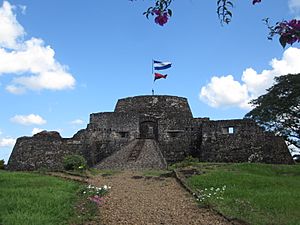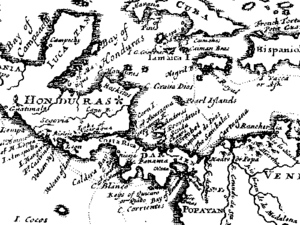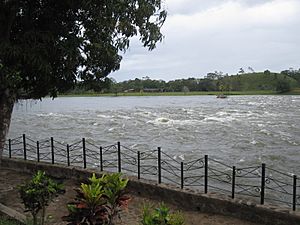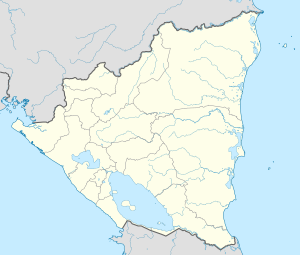Fortress of the Immaculate Conception facts for kids
Quick facts for kids Fortress of the Immaculate Conception |
|
|---|---|
| El Castillo de la Inmaculada Concepción | |
| El Castillo, Río San Juan Department, Nicaragua | |

Fortress of the Immaculate Conception
|
|
|
Location of the Fortress of the Immaculate Conception within Nicaragua
|
|
| Coordinates | 11°01′09″N 84°23′47″W / 11.0192°N 84.3964°W |
| Type | Bastion, Fortress |
| Site information | |
| Controlled by | Nicaragua |
| Open to the public |
Yes |
| Site history | |
| Built | 1673–1675 |
| Built by | Martín de Andújar Cantos |
| In use | 1675–present |
| Materials | Stone |
| Battles/wars | Battle for the Río San Juan de Nicaragua (1762) San Juan Expedition (1780) |
| Garrison information | |
| Past commanders |
Lieutenant Colonel Don José de Herrera y Sotomayor (1762) |
The Fortress of the Immaculate Conception (in Spanish: El Castillo de la Inmaculada Concepción) is a strong fortification in southern Nicaragua. It sits on the southern bank of the San Juan River, in the small village of El Castillo. The fortress is about 6 kilometers from the border with Costa Rica. It is located near the Raudal del Diablo rapids of the San Juan River.
This fortress was finished in 1675. It was part of a group of forts along the San Juan River. Their main job was to protect the city of Granada from pirate attacks. Pirates could sail from the Caribbean Sea up the San Juan River and into Lake Nicaragua to reach Granada. The village of El Castillo and its fortress remained very important for the Spanish government in Central America until the late 1700s.
Today, the fortress is an important historical place in Nicaragua. It is on a special list with UNESCO. This is the first step to becoming a World Heritage Site.
Contents
History of the Fortress
Early Explorations (1500s)
Gil González Dávila was a Spanish explorer. He was the first European to reach what is now Nicaragua. In 1522, he found the large "freshwater sea," which is now called Lake Nicaragua. He thought it might connect to the Caribbean Sea.
Later, another Spanish explorer, Francisco Hernández de Córdoba, founded the city of Granada in 1524. It was built on the shore of Lake Nicaragua. Explorers from Granada soon found a waterway leading east towards the Caribbean Sea. This river was named the Río San Juan. However, it was hard to travel on because of rapids.
Pirate Attacks and Building the Fortress (1600s)

By the late 1600s, the city of Granada was rich and successful. This made it a target for pirates. The first pirate attack happened in 1670. To protect Granada, the Spanish rulers decided to build a strong fortress.
In 1673, a military engineer named Martín de Andújar Cantos chose the best spot for the fortress. They decided to build it at the Raudal del Diablo rapids. This was on top of an older, smaller fort. Construction of the new fortress began on March 10, 1673. It was finished in 1675. Its first name was Fortaleza de la Limpia Pura e Inmaculada Concepción. Even with the new fortress, a buccaneer named William Dampier attacked Granada in 1685 and burned it down.
Battles at the Fortress (1700s)
The Battle of 1762
On July 26, 1762, a large force of British and Miskito soldiers attacked the fortress. This event is known as the Battle for the Río San Juan de Nicaragua. The attackers had two thousand men and over fifty boats. The fortress only had about one hundred soldiers. The commander of the fortress had died just 11 days earlier.
However, the commander's 19-year-old daughter, Rafaela Herrera, showed great bravery. She helped inspire the defenders. She even fired a cannon and killed the British commander! The battle lasted for six days. The defenders, led by Lieutenant Juan de Aguilar y Santa Cruz, won. The British finally gave up and left on August 3, 1762.
The British Capture (1780)
In 1779, Spain joined the American Revolutionary War. A British governor from Jamaica, John Dalling, planned another attack on Nicaragua. The goal was to sail up the San Juan River, capture Lake Nicaragua, and take Granada. This would cut Spanish America in half and possibly open a path to the Pacific Ocean.
This attack happened in 1780 and is called the San Juan Expedition (1780). Colonel John Polson and Captain Horatio Nelson led the British forces. Nelson was only 22 years old at the time. He led his men through thick jungle to attack the fortress from a hill behind it.
The British captured the fortress on April 29, 1780. They held it for nine months. They finally left in January 1781. The hill where Nelson attacked is still called Lomas de Nelson (Nelson's Hills) today.
The Fortress Today (2000s)

The Fortress of the Immaculate Conception is a very important historical site in Nicaragua. Today, it has a museum and a library. Since 1995, it has been on a "tentative list" with UNESCO. This means it is being considered to become a World Heritage Site. The fortress is located in a protected area called the Indio Maíz Biological Reserve.
See also
 In Spanish: Castillo de la Inmaculada Concepción para niños
In Spanish: Castillo de la Inmaculada Concepción para niños
- Piracy on Lake Nicaragua
- Piracy in the Caribbean


